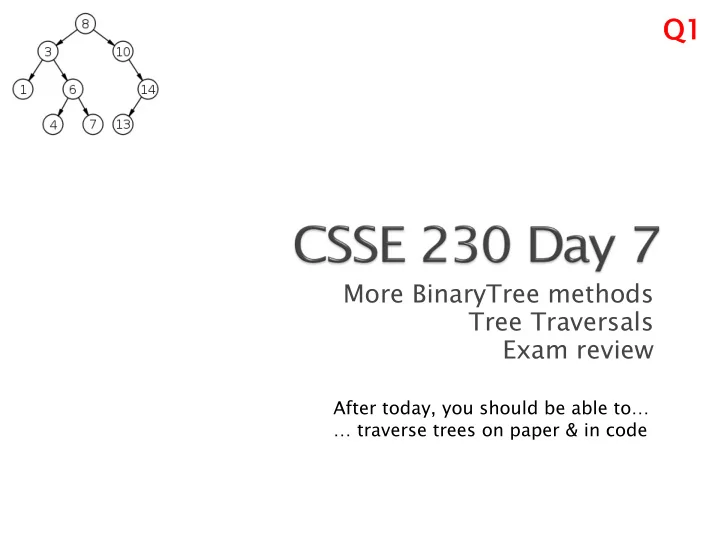

Q1 Q1 More BinaryTree methods Tree Traversals Exam review After today, you should be able to… … traverse trees on paper & in code
} Doublets is next assignment. } Also with a partner – we’ll find partner later. } Instructor demo later
} Please complete the Stacks&Queues partner evaluation in Moodle after you submit your final code. } Optional Exam 1 review session: ◦ TBA: watch piazza
Dr. B’s quiz: What became clear to you as a result of class? CSSE230 student: I was tre tree ted to some good knowledge by the time I le leaf t.
NULL 1 possibility for children: Both 4 possibilities for children (leaf, Left only, Right only, Both) (which could be NULL_NODE)
Simpler Simpler
Comment out unused tests and uncomment as you go Write containsNonBST(T item) now.
} If (node is null) ◦ Return something simple } Recurse to the left } Recurse to the right } Combine results with this node
} If (node is null) ◦ Return something simple } Recurse to the left } Recurse to the right } Combine results with this node
} If (node is null) ◦ Return something simple } Recurse to the left } Recurse to the right } Combine results with this node
} Print the tree } If (node is null) contents ◦ Return something } Sum the values of simple the nodes } Dump the contents } Recurse to the left to an array list } Recurse to the right } Lots more } Combine results with this node } In what order should we print nodes?
2-6 } InOrder (left-to-right, if tree is spread out) ◦ Left, root, right } PreOrder (top-down, depth-first) ◦ root, left, right } PostOrder (bottom-up) ◦ left, right, root } LevelOrder (breadth-first) ◦ Level-by-level, left-to-right within each level
If the tree has N nodes, what’s the (worst- case) big-Oh run-time of each traversal?
6 } Brainstorm how to write: public ArrayList<T> toArrayList() } Then BST toString() will simply be: return toArrayList().toString();
Size(), height(), contains(), toArrayList(), toString(), etc. What if we want an iterator (one element at a time)? Next class
1 } Exam 1 – Day 8: 7-9 pm ◦ Coverage: Everything from reading and lectures, Sessions 1-7 Programs: Warmup, Stacks and Queues Homeworks 1-2 ◦ Allowed resources: Written part: ½ of one side of 8.5 x 11 paper Goal: to let you use formulas but force you to summarize. Programming part: Textbook Eclipse (including programs you wrote in your repos) Course web pages and materials on Moodle Java API documentation A previous 230 Exam 1 is available in Moodle
◦ Written (50-70%): Growable Arrays MCSS big O/ q / W : true/false, using definitions, limits, code analysis Binary search ADT/Collections Choosing an ADT to solve a given problem ◦ Programming (30-50%): Implementing an ADT using an array, nodes, or another ADT
} All data structures really boil down to: ◦ Continuous memory ( ar array ays ), or ◦ Nodes and pointers ( link linked lis lists, t , tre rees, g , gra raphs hs ) } Let’s draw pics of each } Then you do the questions on the back with a partner as exam review } Then time for questions
Recommend
More recommend